For “Queen” Machali, taking down formidable crocodiles seems to be just part of her daily routine.
Once reigning over the Ranthambore National Park in India, which spans over 900 km2 and has become a symbol due to her incredible feats, “Tiger Queen” Machali is perhaps the most famous tiger in the world to date.
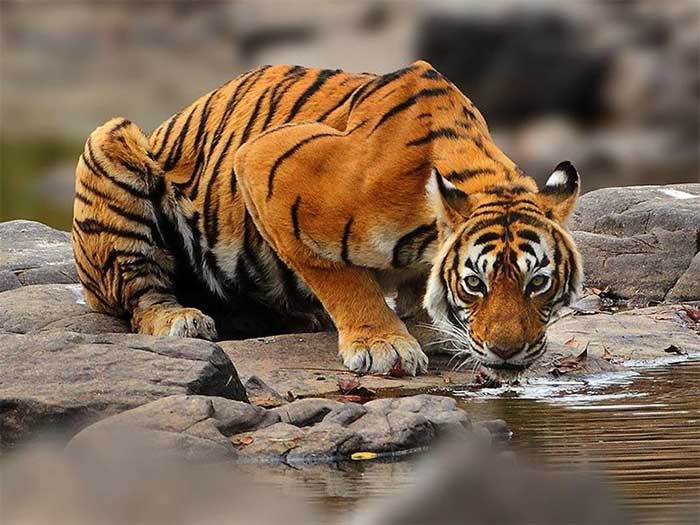
Machali is considered the most famous tiger in the world. (Photo: AP).
She has also provided wildlife enthusiasts with numerous unforgettable stories and inspired a series of documentaries, with “Tiger Queen” being the most notable, winning the National Award at the 66th National Film Awards.
The Legend of Machali T-16
Machali (which means “fish” in Hindi) is a Bengal tiger (Panthera tigris tigris) born in 1997, the eldest of three female cubs. She was given this name because of the fish-like markings on the left side of her face. She is also known by the code name T-16 assigned by the staff at Ranthambore National Park, as well as the nickname “Lady of the Lake.”
Machali showcased her dominance early on, beginning to hunt independently within her first two years. She also displayed her unusual nature by daring to challenge her mother at a young age. Upon winning, Machali became the queen of the Ranthambore lakes, a crucial territory for tigers in the Indian national park, which is also the largest and most beautiful area, covering 906 km2.
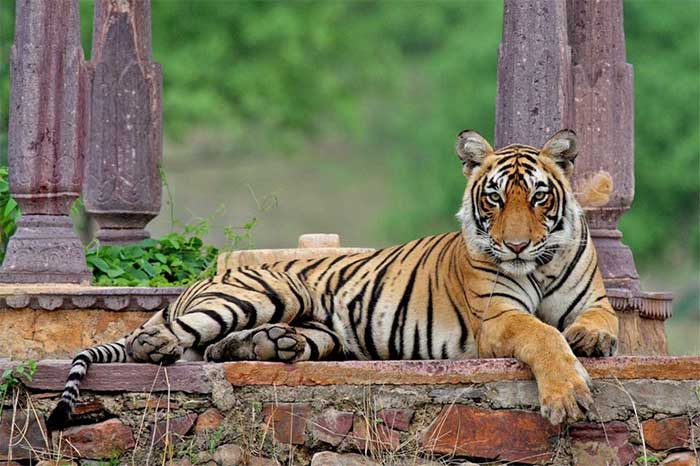
The majestic beauty of Machali the tiger. (Photo: AP).
Kalli Doubleday, a carnivore researcher at the University of Texas, Austin, has harbored a particular fondness for big cats since childhood. Growing up, she learned about Machali and began researching her. Doubleday’s study published in the February 2017 issue of Geoforum revealed unique traits that distinguished Machali from her peers.
According to the research, among the 62 tigers living in Ranthambore at the time, none were as bold and arrogant as Machali. The nickname “Lady of the Lake” was not given to her by chance, as she was an expert at dealing with “huge” crocodiles. Her usual victims were the well-known Mugger crocodiles, which can grow up to 4 to 5 meters long and weigh as much as 200 kg.
Despite being land-dwelling and aquatic species, the Mugger crocodiles and Bengal tigers frequently “cross paths” due to overlapping territories. While Bengal tigers are large and strong, they are also very cautious when confronting Mugger crocodiles, as these reptiles are indeed born killers, equipped with powerful jaws capable of capturing and holding onto large prey such as deer and antelope.
However, for Machali, taking down formidable crocodiles seems to be just part of her daily duties. Yet, there was one battle that forever etched her name in history, making her truly the “Queen” of the vast lands.
This occurred in June 2003 when Ranthambore faced a severe drought, prompting a giant crocodile, measuring 4.8 meters, to leave its shelter and enter the waters within Machali’s territory. After escorting her cubs to safety, Machali returned and left visitors “wide-eyed” as she took down the adversary in a fierce showdown.
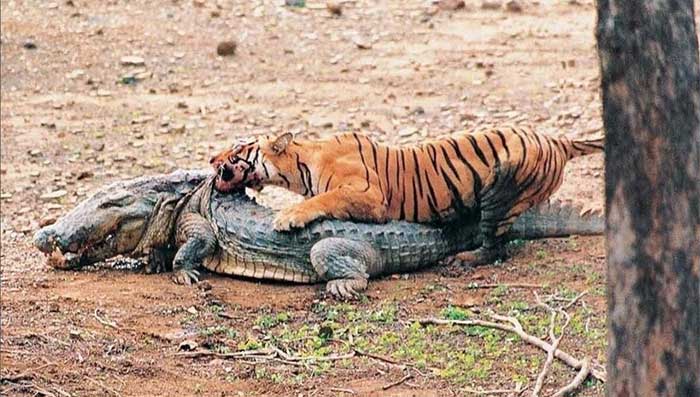
Machali always displayed a dominant nature and a strong personality within her pride.
The battle brought fame to Machali but also cost the “Queen” her sharp fangs—the weapons that instilled fear in many predators and wild animals. However, this did not diminish Machali’s ferocity. Even as a female tiger, Machali consistently exhibited a dominant nature and a strong personality in her pride, at times even subjugating male tigers.
As she grew older, Machali had to raise her cubs despite having lost all her canine teeth and with one eye completely blind. Nonetheless, the “Tiger Queen” never failed to protect her cubs from larger male tigers. Male tigers often kill cubs to persuade females to mate. Despite her disadvantages, Machali stood her ground against such opportunistic threats.
Strong as she was, Machali proved to be extremely friendly with the camera, often lounging on her favorite rock, posing like a true queen for visitors to photograph.
This might be why images of Machali have circulated everywhere, appearing in countless magazines, books, travel blogs… and she became the world’s most valuable “tiger model.”
Legacy and Achievements of the “Queen”
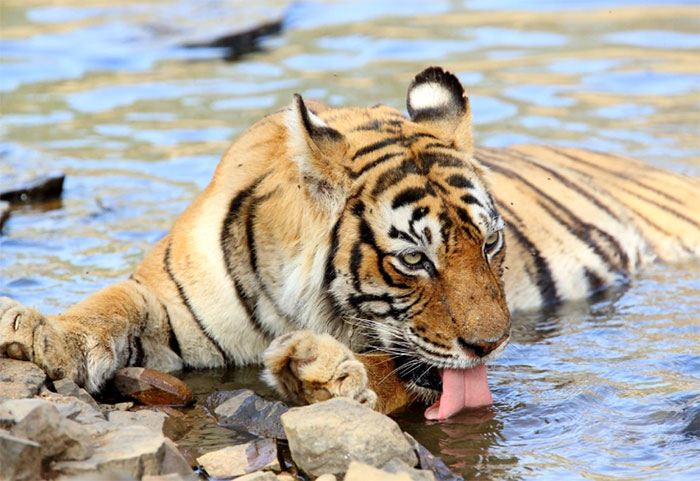
Machali gave birth to four litters, including 11 cubs – 7 females and 4 males.
“Queen” Machali played an important role in the conservation of her own tiger population as well as the global tiger population, which is always threatened by poachers. Over a nearly 20-year lifespan, she gave birth to four litters, totaling 11 cubs—7 females and 4 males.
Machali’s offspring significantly increased the tiger population in the park—from 15 tigers in 2004 to 50 tigers in 2014. Ultimately, more than half of the tigers in the park are descendants of Machali. In 2008, two of Machali’s female tigers were transferred to the Sariska Tiger Reserve, further boosting the tiger population in that area. At that time, the number of tigers sighted in Ranthambore quadrupled within a decade.
Not only did she bring fame to her pride, but also to the vast Ranthambore National Park, attracting thousands of visitors each year. At one point, the park was estimated to generate 220 billion VND (converted) in revenue annually solely from ticket sales. Most visitors came to catch a glimpse of the legendary “Tiger Queen.”
Machali’s influence was so great that the Tiger Tourism Operators (TOFT) awarded the “Queen” a lifetime achievement award in 2009 for her contributions to conservation and tourism.
The Indian government also issued commemorative covers and postage stamps to honor Machali for her economic and ecological contributions as the “Queen.”
Even as Machali aged, she was kept in the Rajasthan park and provided with food. Daily, they would bring an animal, such as a goat, to tie to a tree for Machali. At that time, although she had lost most of her teeth, the “Queen” still had the strength to kill prey due to her powerful bite.
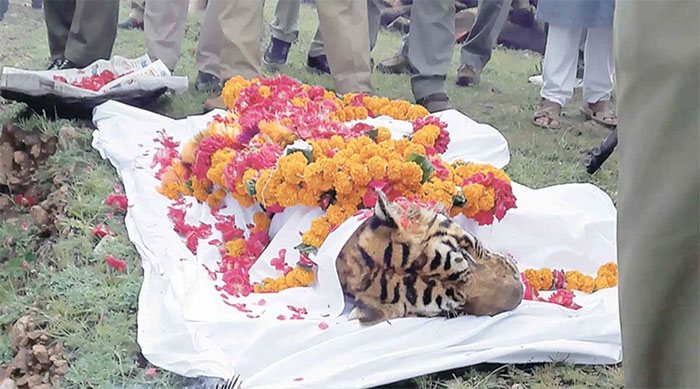
Machali was buried according to Hindu tradition. (Photo: AP).
In August 2016, on a beautiful sunny day, Machali found a quiet spot, lay down, and never woke up again. This scene deeply moved the staff working at the national park.
Typically, Bengal tigers live only 12 to 14 years. However, when Machali passed away, she was over 19 years old. After her death, the tiger was buried according to Hindu tradition, wrapped in white cloth and covered with garlands. All park personnel attended Machali’s cremation ceremony, which is considered one of the most special moments in the history of wildlife conservation worldwide.





















































